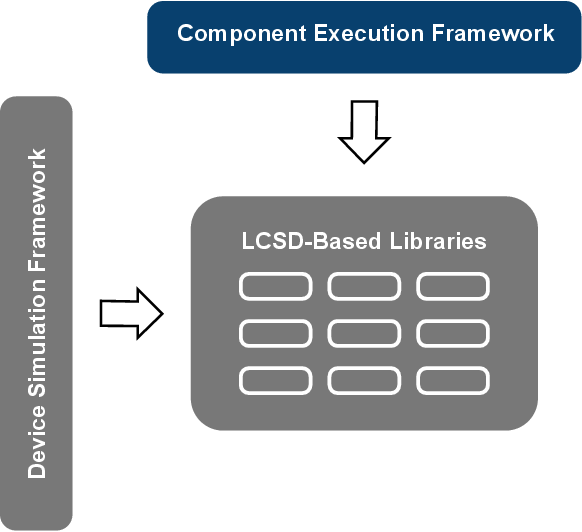Chapter 5
Component Execution Framework
A component execution framework applies CBSE concepts, allowing to setup an
application based on reusable components by connecting them accordingly. For
instance, a FEM-based assembly component forwards the assembled equation system
 to a linear solver component which computes the solution vector
to a linear solver component which computes the solution vector  . As
already indicated, the strength of such an approach is based on the growing potential
for reusability - as more and more components are added to the set of available
components - and on the significantly increased level of flexibility - as components can be
exchanged in a straightforward manner. This fact is especially of interest to HPC
applications, as a plethora of, for instance, linear solver libraries or finite element analysis
libraries are available, consequently introducing the urge to exchange individual
tools. Therefore, component execution frameworks merit special consideration for
implementing simulation tools as compared to monolithic application approaches.
Such frameworks thus provide an alternative to simulator software design. Most
importantly, though, such frameworks can wrap - and thus reuse - already available
functionality. Therefore, component execution frameworks further benefit from the
LCSD approach similarly to the previously discussed device simulation framework
(Figure 5.1).
. As
already indicated, the strength of such an approach is based on the growing potential
for reusability - as more and more components are added to the set of available
components - and on the significantly increased level of flexibility - as components can be
exchanged in a straightforward manner. This fact is especially of interest to HPC
applications, as a plethora of, for instance, linear solver libraries or finite element analysis
libraries are available, consequently introducing the urge to exchange individual
tools. Therefore, component execution frameworks merit special consideration for
implementing simulation tools as compared to monolithic application approaches.
Such frameworks thus provide an alternative to simulator software design. Most
importantly, though, such frameworks can wrap - and thus reuse - already available
functionality. Therefore, component execution frameworks further benefit from the
LCSD approach similarly to the previously discussed device simulation framework
(Figure 5.1).
In the following, an overview of today’s HPC platforms (Section 5.1) is provided. Based on
the established basis for computing targets the requirements and challenges of implementing
a component execution framework for the general application in the area of CSE are
discussed (Section 5.2). These discussed aspects give rise to the in the course of
this work developed component execution framework which is introduced in detail
(Section 5.3).
 to a linear solver component which computes the solution vector
to a linear solver component which computes the solution vector  . As
already indicated, the strength of such an approach is based on the growing potential
for reusability - as more and more components are added to the set of available
components - and on the significantly increased level of flexibility - as components can be
exchanged in a straightforward manner. This fact is especially of interest to HPC
applications, as a plethora of, for instance, linear solver libraries or finite element analysis
libraries are available, consequently introducing the urge to exchange individual
tools. Therefore, component execution frameworks merit special consideration for
implementing simulation tools as compared to monolithic application approaches.
Such frameworks thus provide an alternative to simulator software design. Most
importantly, though, such frameworks can wrap - and thus reuse - already available
functionality. Therefore, component execution frameworks further benefit from the
LCSD approach similarly to the previously discussed device simulation framework
(Figure 5.1).
. As
already indicated, the strength of such an approach is based on the growing potential
for reusability - as more and more components are added to the set of available
components - and on the significantly increased level of flexibility - as components can be
exchanged in a straightforward manner. This fact is especially of interest to HPC
applications, as a plethora of, for instance, linear solver libraries or finite element analysis
libraries are available, consequently introducing the urge to exchange individual
tools. Therefore, component execution frameworks merit special consideration for
implementing simulation tools as compared to monolithic application approaches.
Such frameworks thus provide an alternative to simulator software design. Most
importantly, though, such frameworks can wrap - and thus reuse - already available
functionality. Therefore, component execution frameworks further benefit from the
LCSD approach similarly to the previously discussed device simulation framework
(Figure 5.1).
